How to Create Custom Column Sorting During Shopware 6 Export

Let’s delve into the practicalities of Shopware 6 export, showing you how to implement custom column sorting. From the initial setup to the final export, this process is quite intuitive and user-friendly. At the same time, it lets you dive deep into the customization of your export tables, making them more suitable for external demands. So, we are going to focus on why flexibility is good for Shopware 6 export, how to use the default Shopware 6 tools to create a custom column order, and what alternatives to use instead. With this article, you’ll understand how to tailor your exports according to your unique needs. For further useful materials, visit our Shopware Cookbook.

Table of contents
The Advantages of Flexible Shopware 6 Export
Flexibility in Shopware 6 data export is associated with multifaceted advantages. This versatility encompasses various elements that together contribute to an enhanced data management experience. Below, you will discover the pivotal aspects that underscore the importance of such flexibility:
- Mapping introduces the ability to tailor data to one’s precise requirements, no matter whether you deal with import or export processes. This invaluable asset enables users to correlate the exported or imported data with their specific needs, ensuring seamless integration with other systems or platforms. With mapping, users get the ability to assign particular data points to corresponding attributes, thereby achieving a more coherent and structured output.
- Incorporating default values during export furnishes an additional layer of reliability. This safeguard ensures that in instances where specific data fields are empty, predefined default values fill the void. Thus, default values bolster consistency in exported data, assuring that your output maintains a standardized format, regardless of variations in the source data.
- Customizable column order ensures the ability to arrange columns in a bespoke order. It is another flexibility feature of great significance developed to organize data elements in a manner that best aligns with your unique objectives. Custom column order fosters clarity and efficiency, simplifying data interpretation and analysis for both domestic employees and third-party systems.
- With a user-centric approach, a flexible export system places the admin at the center of the data management process, adapting to their specific needs and preferences. This way of arranging data import and export processes enhances the overall system usability, allowing for a more intuitive and personalized experience.
With these features, you are much better prepared for diverse scenarios. The adaptability inherent in a flexible export system accommodates a wide array of use cases and scenarios. Whether it is complex data structures, diverse business requirements, or varying data sources, a versatile system rises to the occasion. In essence, flexibility serves as a universal tool, catering to a spectrum of unique circumstances and mitigating potential data management challenges.
At the same time, you get the ability to streamline and automate repetitive workflows. By facilitating tailored data exports, a flexible system introduces a perfect opportunity to streamline workflow and minimize the need for manual interventions. The result is a more efficient data management process that reduces the risk of errors and saves valuable time and resources.
Does Shopware adhere to these standards? Yes, it does. The flexibility in export operations within Shopware 6 is the linchpin of effective data management. From customizable mapping to the integration of default values and the ability to structure columns according to one’s preferences, it introduces user-centric, adaptable, and streamlined data export processes. At the same time, the Improved Import, Export & Mass Actions app exceeds the existing boundaries of data export even further, empowering users to harness the full potential of their data to facilitate clarity, consistency, and efficiency in their e-commerce endeavors.
Let’s look at the default Shopware 6 export first and then proceed to our app to see how to create custom column sorting in Shopware 6 export processes.
How to Create Custom Column Order in Default Shopware 6 Export
Let’s explore the intricacies of crafting a mapping scheme with a custom column order for your Shopware 6 export. While it may initially appear to be a technical endeavor, rest assured, it’s far from being a complex matter.
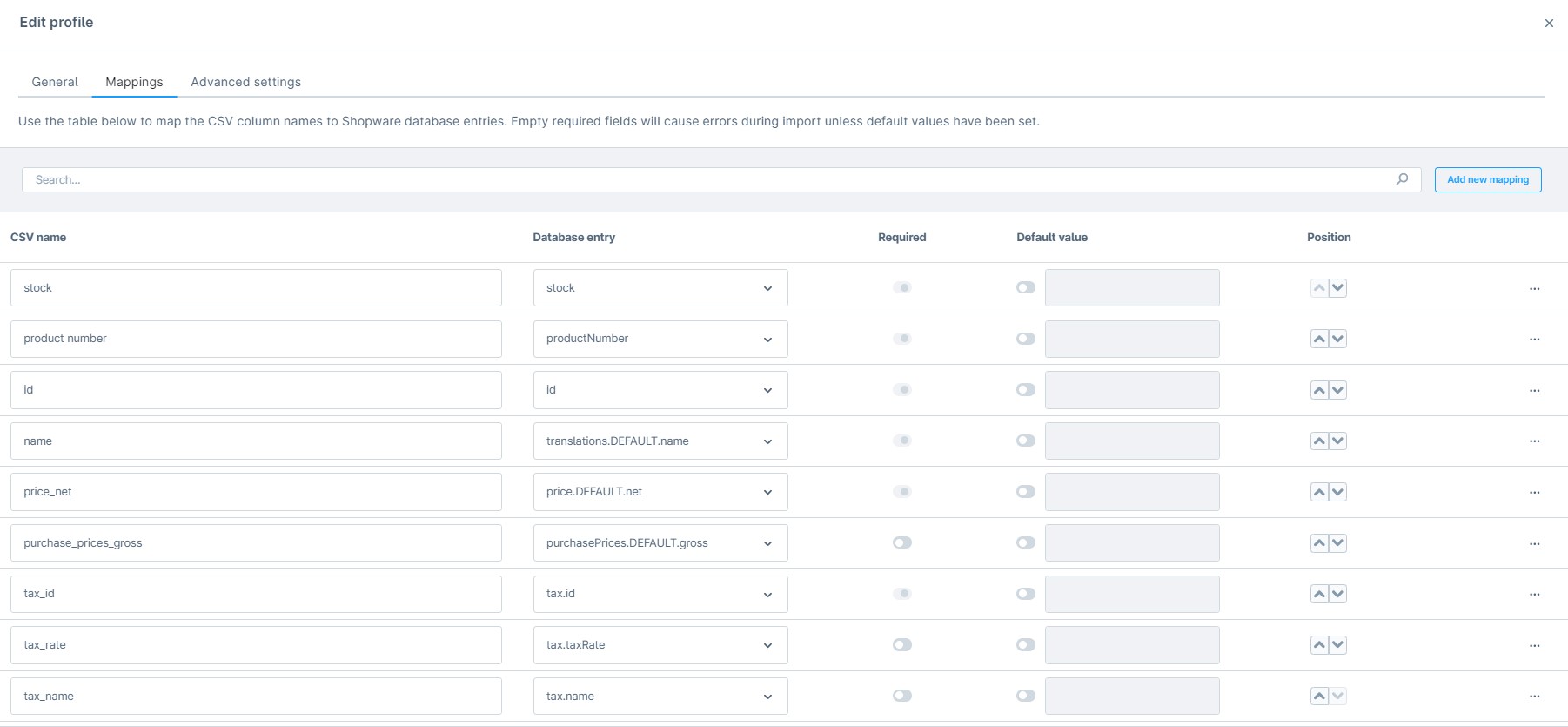
Add New Mapping
While on a new export profile screen, proceed to its mappings tab. Initiate the process by clicking the “Add new mapping” button, which promptly introduces a new entry into your mapping section. Align a CSV entry with a corresponding database record. Add as many mappings as your profile necessitates. For export processes, the system will exclusively incorporate the columns specified within the mapping screen of your profile into the resultant output.
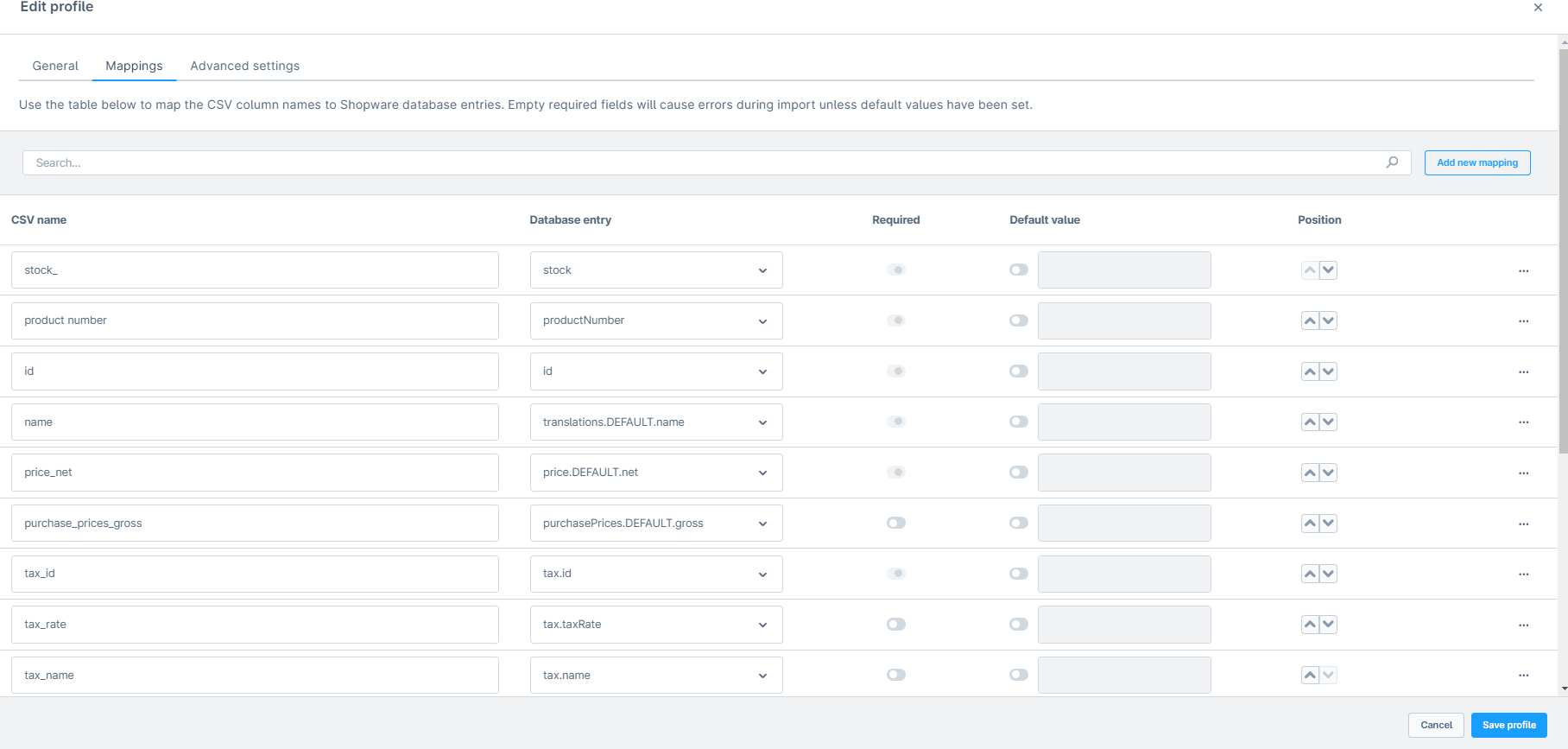
Designate Essentiality
This part of the configuration implies your import profiles. The toggle labeled “Required” empowers you to determine whether a field is indispensable. Activating this toggle elevates the field to a status of necessity. Consequently, the corresponding section within your import file is mandatory. Neglecting to fulfill this requirement will result in an import error.
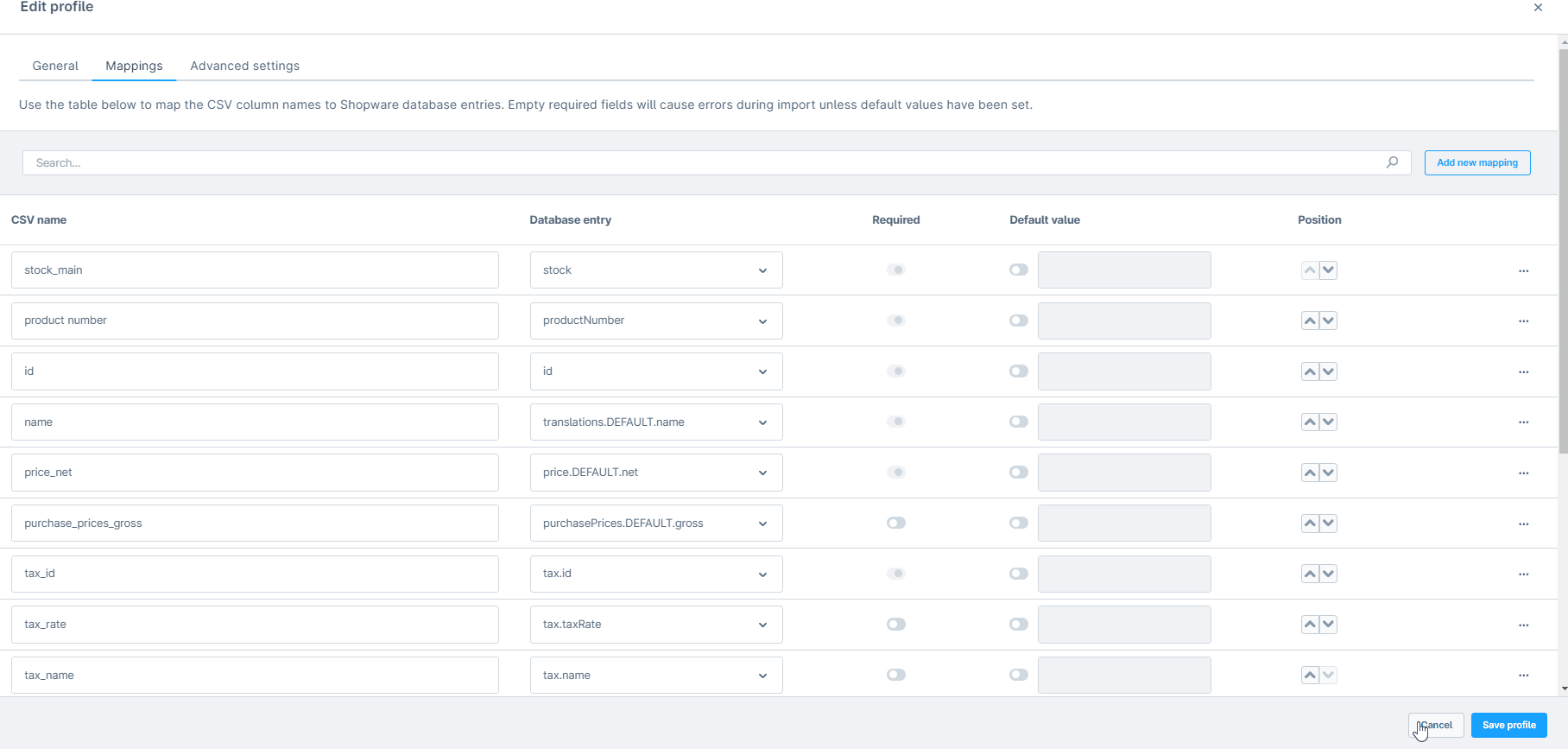
Establish Default Values
Shopware 6 introduces the ability to define default values. Should an import file feature an empty field, these predefined values come to the rescue during the import process, akin to a contingency plan poised for action. At the same time, you can use them for export.
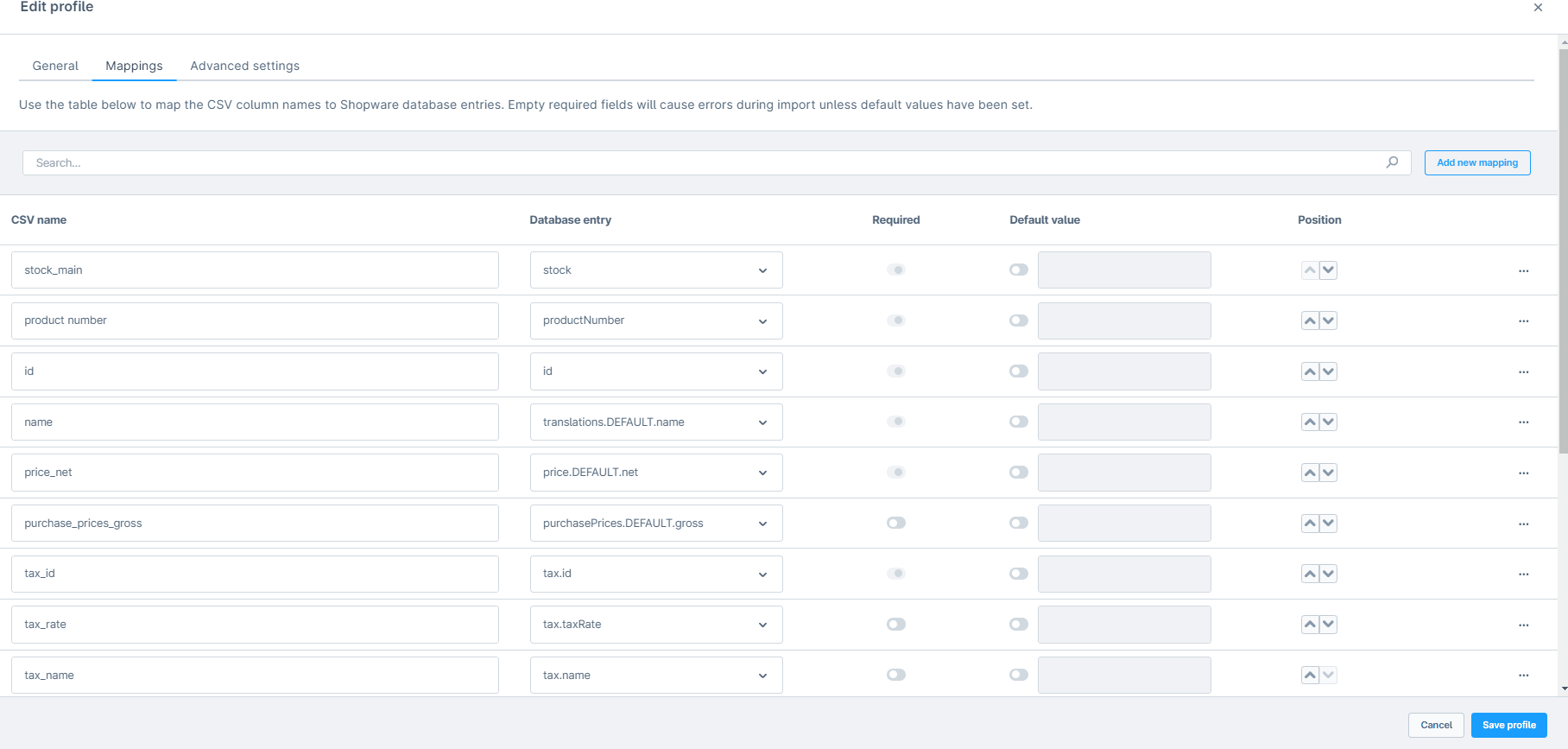
Determine Field Placement
Now, let us delve into the realm of Shopware 6 custom column sorting. The corresponding column on your mappings tab facilitates the specification of where the corresponding field may manifest within your CSV file. Its primary function revolves around organizational coherence, ensuring that each element finds its rightful place. You only need to click the corresponding arrow, moving the column up or down.

As you can see, creating a custom column order in Shopware 6 export is a simple routine. However, there is a way to do it even more efficiently.
Custom Export Column Order with Improved Import, Export & Mass Actions
Improved Import, Export & Mass Actions is a robust replacement for the default Shopware Import/Export interface. This app introduces numerous advantages over the built-in solution, but let’s focus on its beneficial approach to custom column sorting.
Start a new export profile under Settings -> Improved Import, Export & Mass Actions -> Export. Hit the New Profile button to get to the Configure export screen. Here, you can configure basic export settings. We don’t focus on this part of your export routine in this post, so follow our Manual for Improved Import, Export & Mass Actions for a more detailed description of this section.
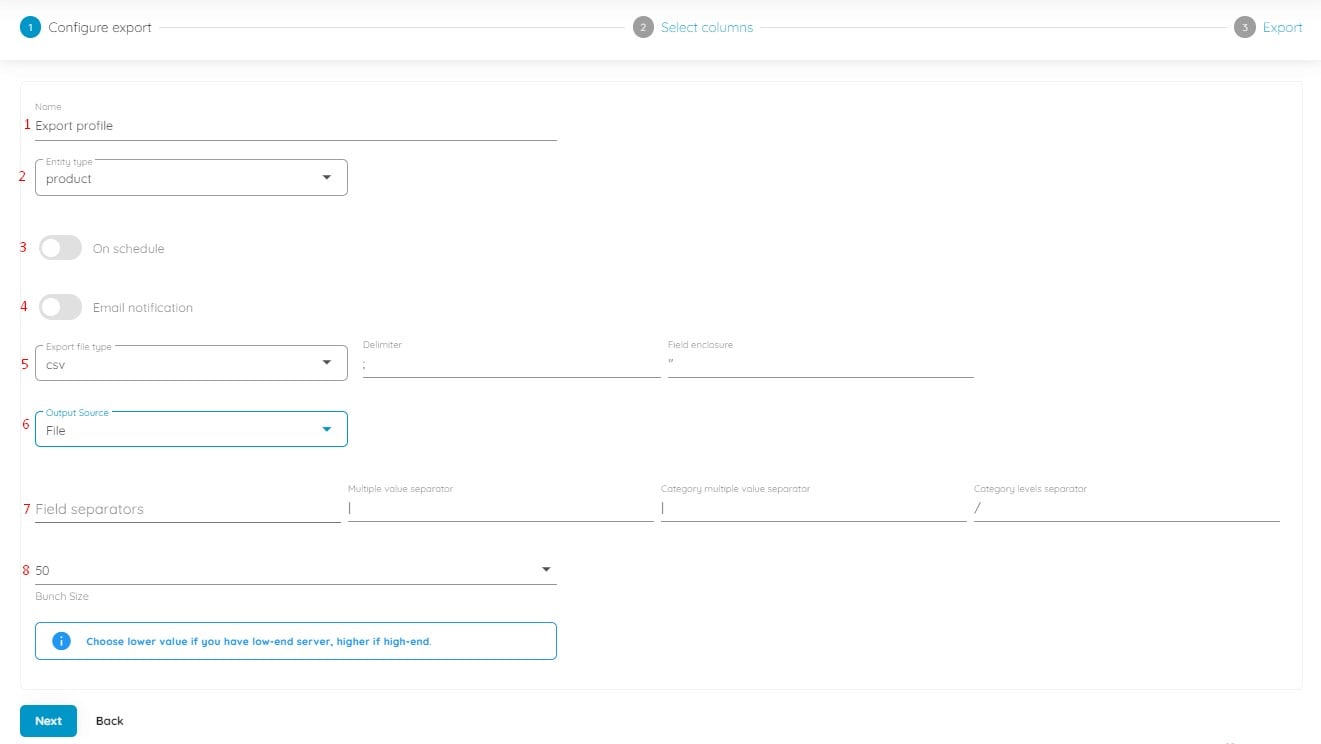
When you are ready, click Continue to proceed to the Select columns screen. It’s a place where Shopware export mapping takes place and you can create a custom column sorting.
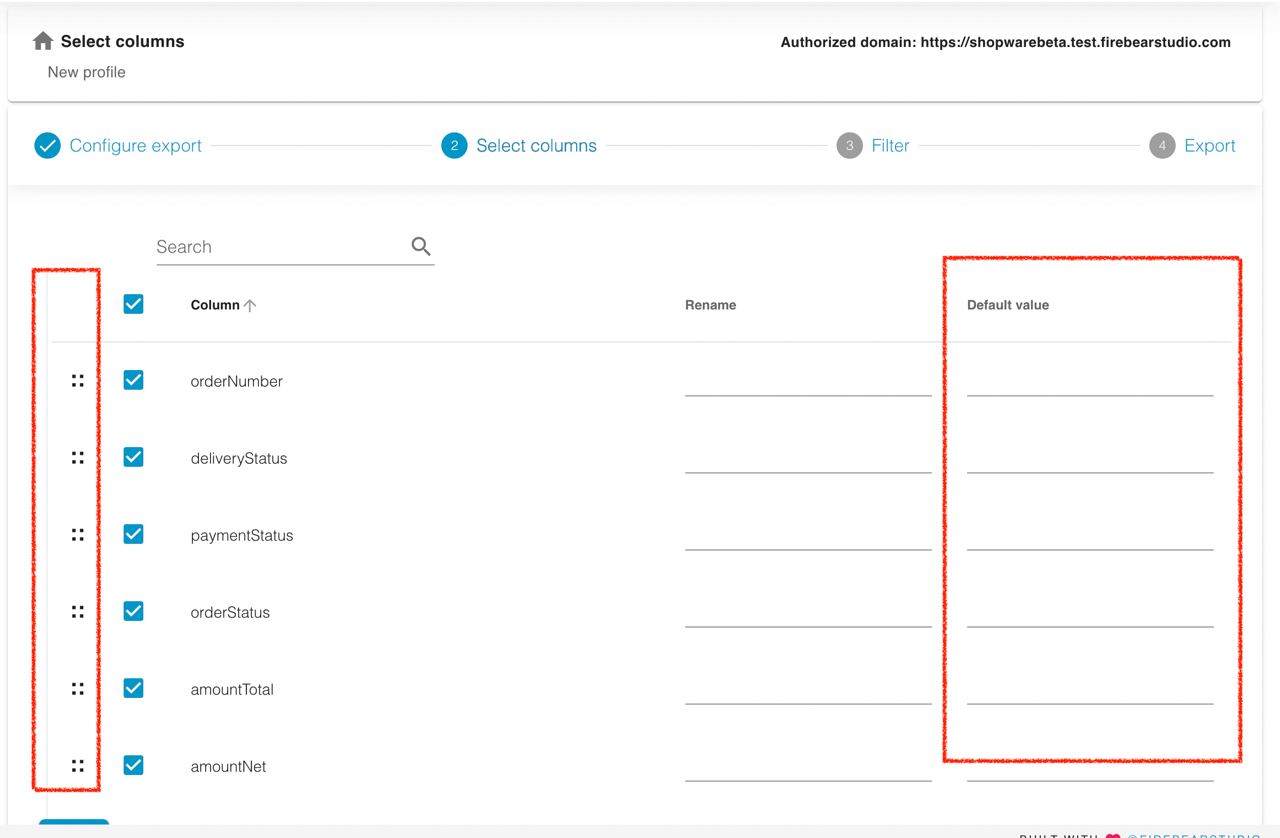
You can rename default column titles by adding a new name (Rename) after the existing column name (Column).
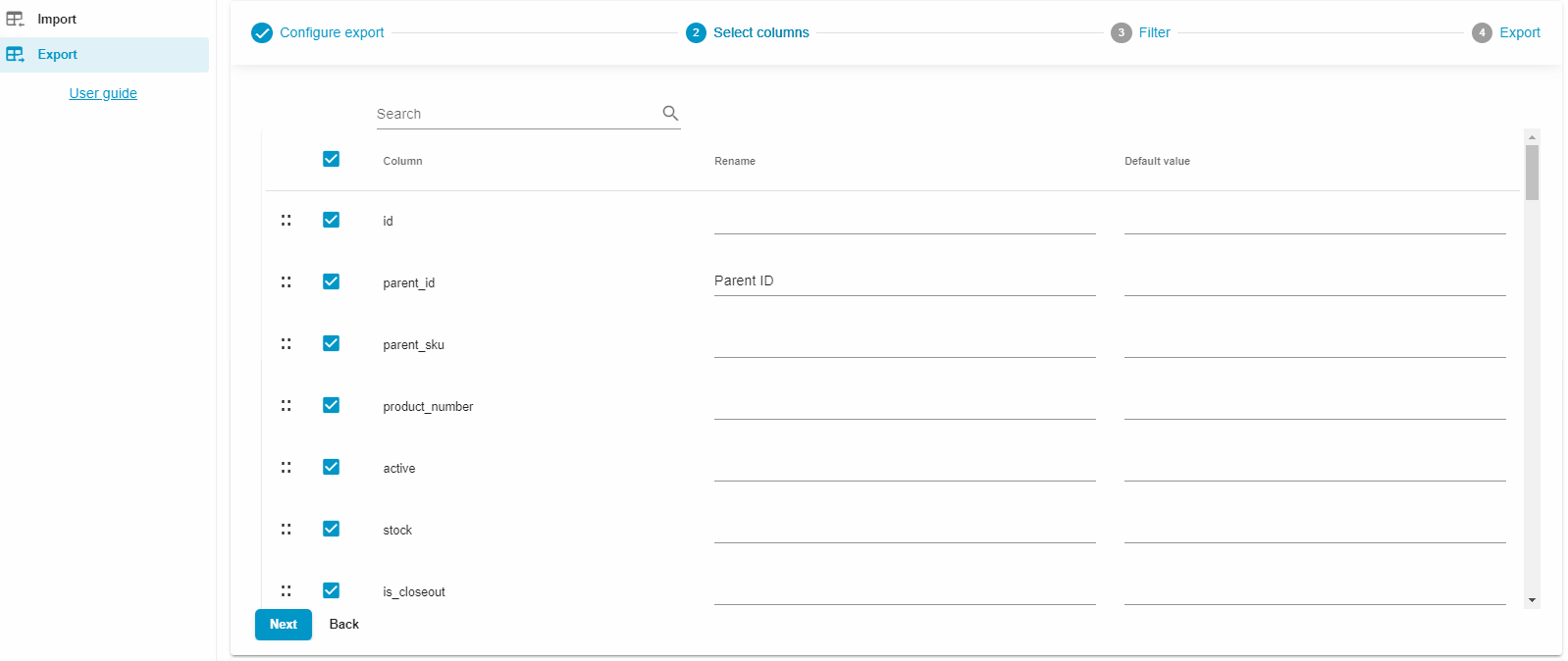
Additionally, you have the flexibility to uncheck any columns you prefer not to include in the export.
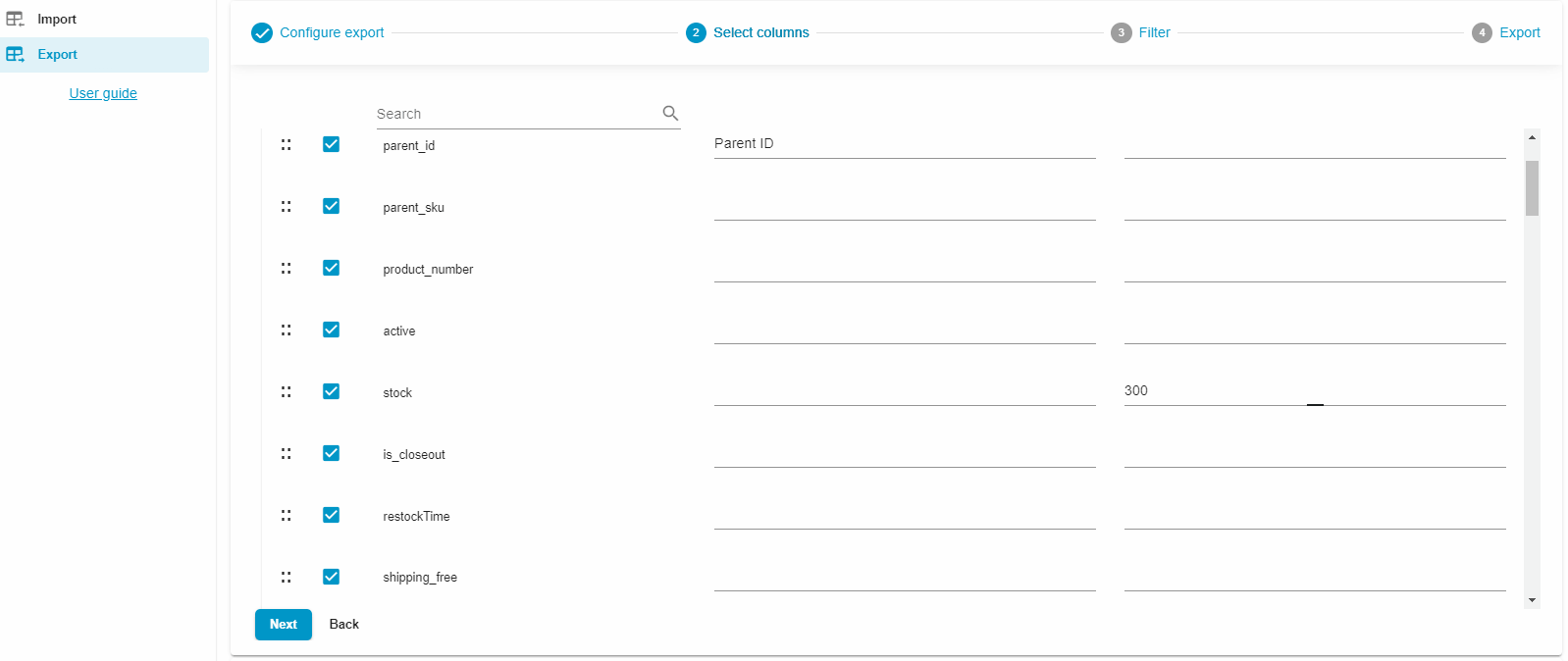
Column sorting is achieved through a simple drag-and-drop interface. Just click on the column you want to move and drag it to the desired place. It is way more convenient than clicking on arrows.
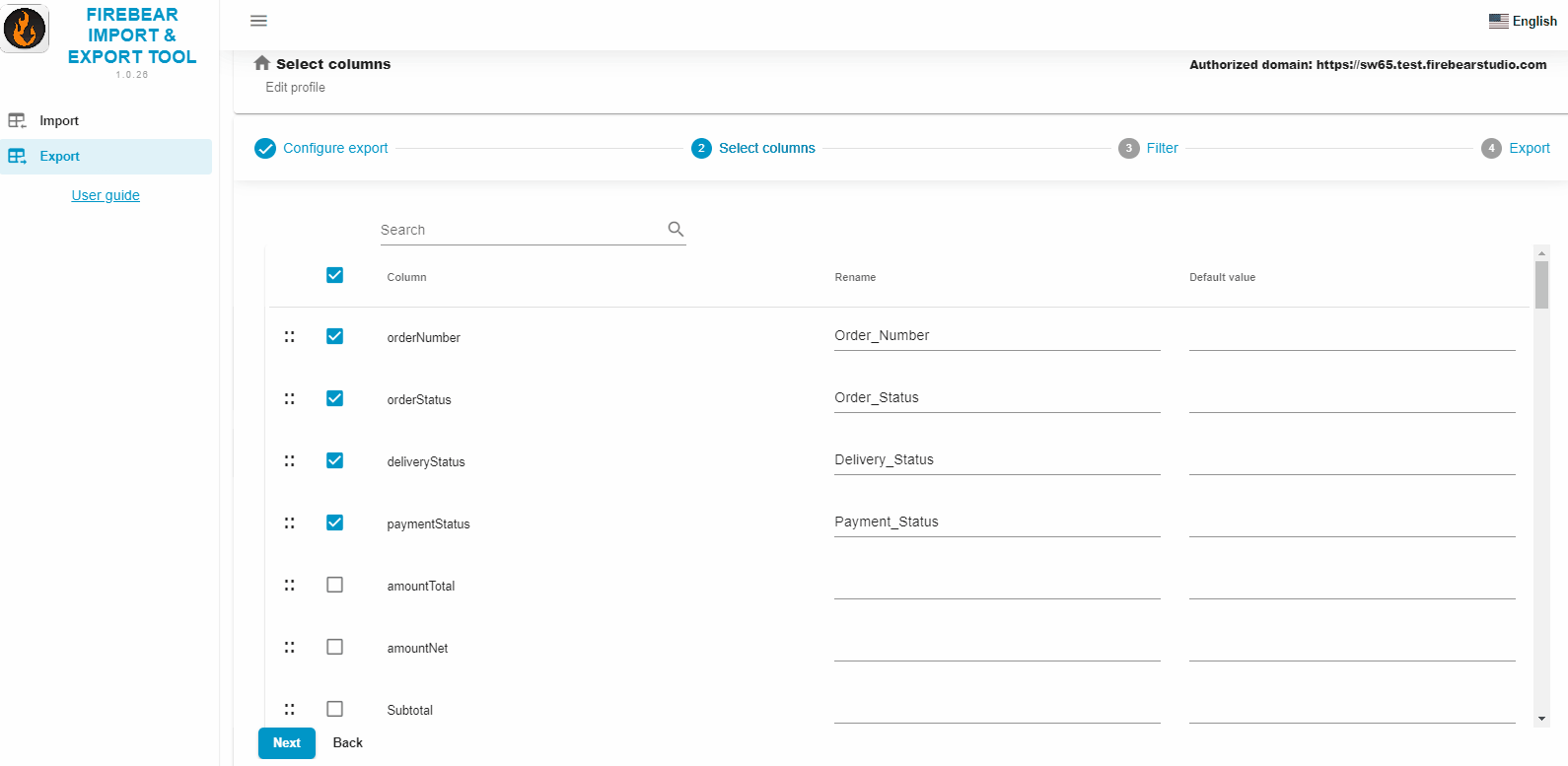
You can also include default values at this stage but we focus on this topic in another article.
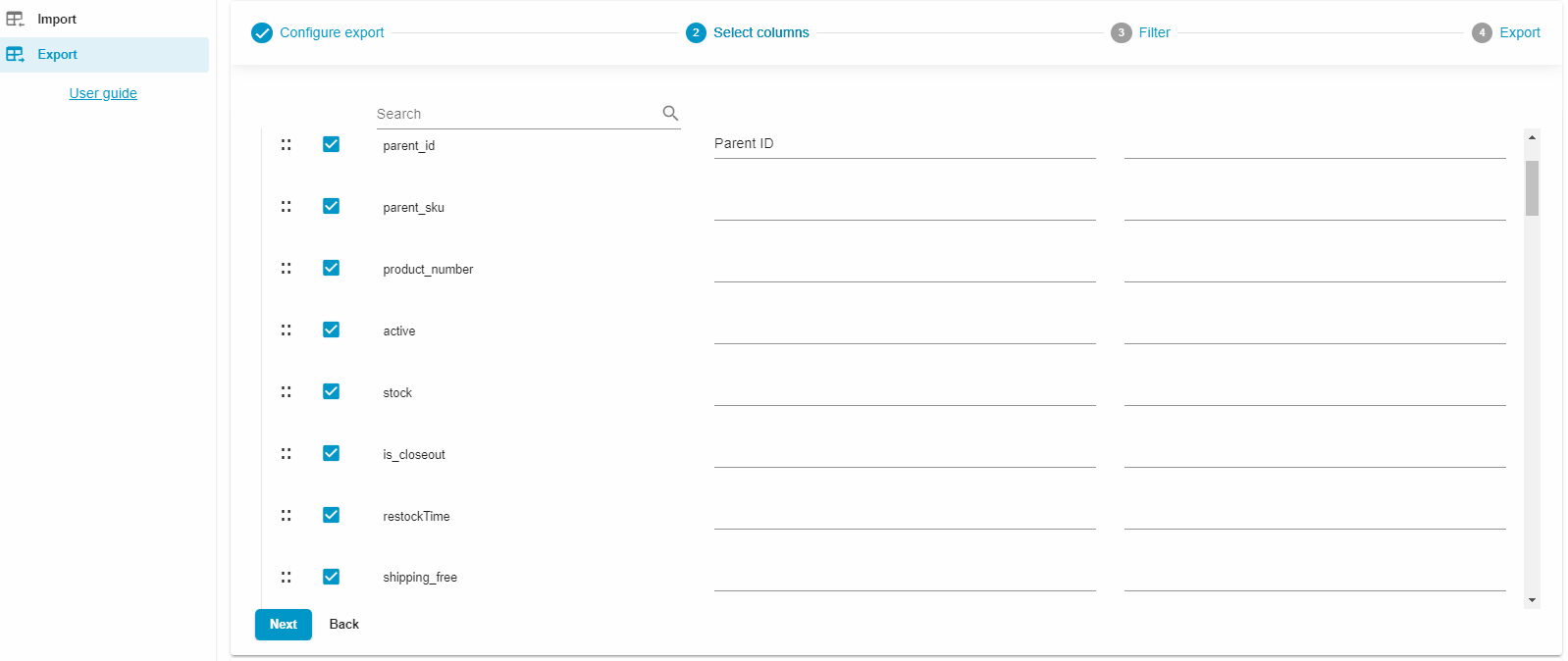
Click Continue to proceed to the Filter screen. Here, you can create filters to narrow down the selection of records in your export table. Note that this functionality is not available by default. Follow our Manual for Improved Import, Export & Mass Actions for more information about filters.
Initiate the data transfer procedure when you are ready.
Key Benefits Over Shopware
Why should I use Improved Import, Export & Mass Actions instead of the default solution, you will ask? Well, our tool offers lots of benefits over the built-in export tool of Shopware 6:
- Drag-&-Drop Interface. Simply drag and drop your columns to a new place instead of endlessly clicking on arrows to rearrange the new position.
- Automated Scheduling: Effortlessly automate your import and export operations by defining the update frequency and precise transfer times, saving you time and effort. Keep the same pre-defined custom column sorting in every automated export for each profile.
- Real-Time Notifications: Stay in the know with instant alerts for both successful and unsuccessful import/export processes, allowing for swift responses and issue resolution.
- Full Product Export: Tailor your exports with ease, ensuring that even custom properties are included, maintaining the link to their associated products for seamless data integrity.
- Export Filters: Create filters to narrow down the selection of records (products orders, or customers) in your export table. Transfer only those records you need rather than the entire database.
- Extended File Format Compatibility: Work directly with XML and XLSX files, eliminating the need for file format conversions and simplifying your data management.
- Google Sheets Integration: Seamlessly transfer data between Shopware 6 and Google Sheets, facilitating collaborative data editing and sharing.
- Versatile Data Transfer: Implement data transfers over FTP/SFTP or between your store and Google Drive, providing flexibility in data management approaches.
Final Words
The option to specify the custom column order during exports is a critical feature in the field of Shopware 6 data management. This feature not only improves the clarity and structure of exported data but also streamlines the whole data management process, ensuring that the appropriate information reaches the right place.
Although column order customization may be difficult with Shopware’s native capabilities, it may result in data outputs that are less customized to the user’s specific needs. This constraint may lead to time-consuming data interpretation, human interventions, and, as a result, a less efficient routine.
The Improved Import, Export, and Mass Actions app, on the other hand, overcomes these restrictions by providing a comprehensive solution that gives users exact control over column order during exports. This adaptability allows businesses to format their data in a way that ideally corresponds with their operational requirements.
The advantages of more flexibility go beyond simply convenience. It guarantees that data is consistent, intelligible, and adapted to individual needs, lowering the possibility of errors and saving time. Furthermore, the Improved Import, Export, and Mass Actions app enables users to incorporate custom mapping techniques, automate import and export processes, get real-time notifications, and operate with a wider choice of file formats, including XML and XLSX, and sources, such as Google Drive or Google Sheets.
Learn more about our app here:
- Firebear Improved Import, Export & Mass Actions for Shopware 6
- Firebear Improved Import, Export & Mass Actions Manual
- Contact us

